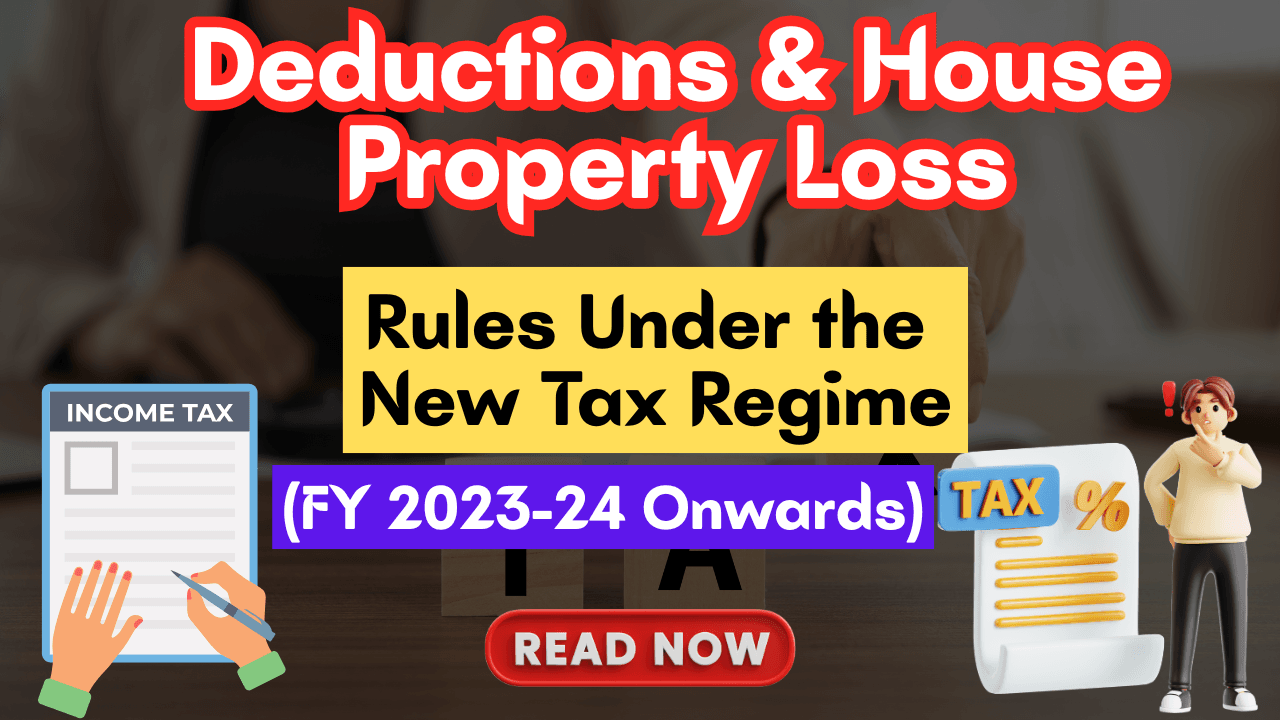New Tax Regime
The New Tax Regime introduced under Section 115BAC of the Income Tax Act aims to simplify tax compliance by offering lower tax rates without most of the common exemptions and deductions available in the Old Tax Regime. New Tax Regime However, the misconception that no deductions are allowed under the new regime is not entirely true.
In this blog, we’ll explore:
- ✅ Which deductions are still allowed under the new tax regime
- 🏠 How house property loss is treated
- 🔍 Important changes made by Budget 2024
✅ Deductions Allowed Under the New Tax Regime
New Tax Regime Although the new tax regime disallows popular deductions like Section 80C, 80D, and HRA exemption, certain essential exemptions and deductions are still permitted.
Here’s a complete list of deductions and exemptions allowed:
Employer’s Contribution to NPS – Section 80CCD(2)
- This deduction is still allowed under the new regime.
- Applies to employer’s contribution, not the employee’s.
- Earlier limit: Up to 10% of salary (Basic + DA).
- Budget 2024 update: Limit increased to 14% for all employees (previously only for Central Govt. employees).
- This deduction is over and above the ₹75,000 standard deduction.
Standard Deduction (Salary and Pension Income)
- From FY 2023-24, the new regime provides a flat ₹75,000 deduction from:
- Salary income
- Pension income (for retired individuals)
- Earlier, standard deduction was available only under the old regime.
Family Pension Deduction – Section 57(iia)
- Available for legal heirs receiving family pension.
- Deduction: Lower of ₹15,000 or 1/3rd of pension received.
- However, under the new regime, this has been raised to ₹25,000 maximum deduction.
Agniveer Corpus Fund – Section 80CCH(2)
- Applicable only to individuals enrolled under the Agnipath Scheme.
- Deduction is available for entire contribution made to the Agniveer Corpus Fund (employee’s contribution + matching government contribution).
Transport Allowance for Specially-Abled Employees
- Exemption of ₹3,200 per month is allowed if the employee is physically disabled.
- This helps compensate for higher commuting costs.
Conveyance Allowance
- Given for official travel or for performing duties outside the office.
- Fully exempt to the extent of actual expenditure incurred.
Tour, Transfer, and Travel Allowance
- Allowance given to employees to cover costs for business travel, relocation, or transfers.
- Exempt from tax if used for the intended purpose and properly documented.
Daily Allowance
- Allowance to cover daily expenses like food, lodging, and local travel when working away from headquarters.
- Fully exempt to the extent of actual expenses incurred.
Perquisites Used for Official Purposes
- Certain perks like:
- Office laptops
- Mobile phones
- Official vehicles
- Are exempt from tax when used only for official duties.
https://www.incometax.gov.in/iec/foportal/
Retirement Benefits – Exemptions Under Section 10
You can still enjoy the following exemptions under the new regime:
- 🏦 Gratuity – Section 10(10)
Up to ₹20 lakhs exempt for non-government employees. - 🧾 Leave Encashment – Section 10(10AA)
Exempt up to ₹3 lakhs for non-government employees. - 👥 Voluntary Retirement Compensation – Section 10(10C)
Exempt up to ₹5 lakhs if conditions are met under VRS rules.
Gifts Received (Section 56(2)(x))
- Gifts received up to ₹50,000 in a year from non-relatives are exempt from tax.
- Gifts from relatives, on the occasion of marriage, or through inheritance are also tax-free.
Interest on Home Loan – Section 24(b)
- Deduction for interest on home loan is not allowed for self-occupied property under the new regime.
- However, if the property is let out, interest deduction is allowed only up to the amount of rental income (not beyond that).
🏠 House Property Loss Rules Under the New Tax Regime
One of the major drawbacks of the new regime is the limited treatment of house property losses. Here’s how it works:
❌ 1. No Deduction for Interest on Self-Occupied Property
- Under the old regime, up to ₹2 lakh interest on loan for self-occupied house was deductible.
- New regime disallows this benefit entirely.
⚠️ 2. Limited Deduction for Let-Out Property
- You can claim interest deduction only up to the rental income received.
- If your interest exceeds rent, the excess cannot be claimed as loss.
❌ 3. No Set-Off Against Other Income
- Under the old regime, house property loss (especially due to interest on home loan) could be set off against salary/business income.
- New regime does not permit this set-off.
❌ 4. No Carry Forward of Loss
- Any loss from house property cannot be carried forward to future years under the new regime.
🧾 Summary Table
| Component | Allowed Under New Regime? | Remarks |
| Standard Deduction | ✅ ₹75,000 | From FY 2023-24 |
| Employer’s NPS Contribution | ✅ Up to 14% | Section 80CCD(2) |
| Family Pension Deduction | ✅ Up to ₹25,000 | Section 57(iia) |
| Agniveer Corpus Fund | ✅ Full amount | Section 80CCH(2) |
| Transport (Disabled) | ✅ ₹3,200/month | Specially-abled only |
| Conveyance Allowance | ✅ | For official duty |
| Perquisites (Official Use) | ✅ | Laptops, phone, etc. |
| Retirement Benefits | ✅ | Sections 10(10), 10(10AA), 10(10C) |
| Interest on Home Loan (SOP) | ❌ Not allowed | No ₹2 lakh deduction |
| Interest on Home Loan (LOP) | ✅ Limited to rent | No loss allowed |
📝 Final Thoughts
The new tax regime is a great option for individuals who don’t claim many deductions and prefer lower tax rates with simplified compliance. However, salaried individuals with home loans, HRA, 80C/80D investments, and other deductions might benefit more from the old regime.
🧠 Tip: Compare your tax liability under both regimes before choosing. You can switch between regimes every year (if you don’t have business income).
Need help calculating your taxes under the new regime?
Drop your questions in the comments or get in touch for a free consultation!
For More Information : https://taxgyany.com/

